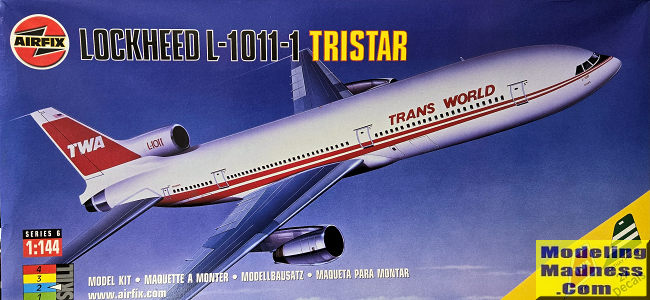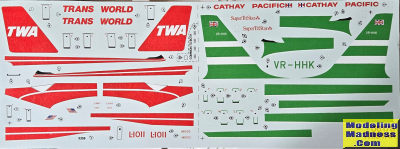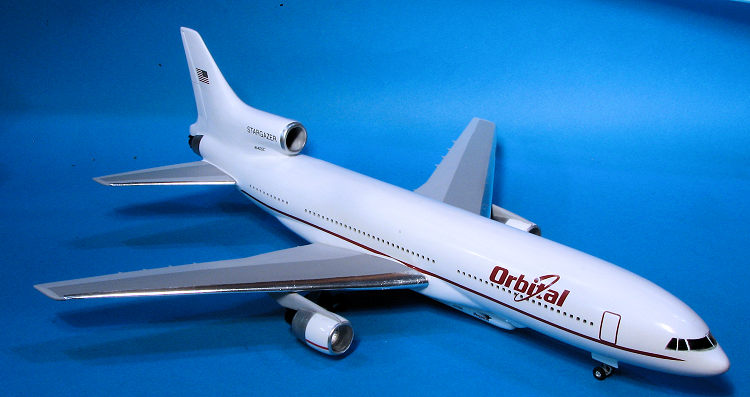
Airfix 1/144 Lockheed L.1011
| KIT #: | 06178 |
| PRICE: | € |
| DECALS: | Two options |
| REVIEWER: | Scott Van Aken |
| NOTES: | 2002 release |

| HISTORY |
The Lockheed L-1011 TriStar (pronounced "El-ten-eleven") is an
American medium-to-long-range, wide-body trijet airliner built by the Lockheed
Corporation. It was the third wide-body airliner to enter commercial operations,
after the Boeing 747 and the McDonnell Douglas DC-10. The airliner has a seating
capacity of up to 400 passengers and a range of over 4,000 nautical
miles (7,410 km; 4,600 mi). Its trijet configuration has three Rolls-Royce
RB211 engines with one engine under each wing, along with a third engine
center-mounted with an S-duct air inlet embedded in the tail and the
upper fuselage. The aircraft has an autoland capability, an automated descent
control system, and available lower deck galley and lounge facilities.
The L-1011 TriStar's sales were hampered by two years of delays due to developmental and financial problems at Rolls-Royce, the sole manufacturer of the aircraft's engines. Between 1968 and 1984, Lockheed manufactured a total of 250 TriStars, assembled at the Lockheed plant located at the Palmdale Regional Airport in southern California north of Los Angeles. After L-1011 production ended, Lockheed withdrew from the commercial aircraft business due to its below-target sales.
| THE KIT |
Initially released in 1971, this is the most recent re-issue of that kit that provides little more than new decals. The initial release date means that this one is raised panel lines all along save for the control surfaces. Typical of Airfix airliners of the time, all the doors on the kit are separate items. I've never understood why that was done as the kit has no interior detailing at all. There is a forward bulkhead and an intake blanking plate for the central engine that have to be installed prior to closing the fuselage halves. Though the instructions don't indicate such, there are a number of short lengths of clear cabin windows that can be installed, though masking them would be tedious. Not sure if any nose weight is needed as none is indicated, but when I built this kit in 2017 I don't recall using any.
Both the wings and tailplanes are upper/lower pieces with the control surfaces molded into the upper half. The kit can be built with the landing gear raised or lowered. No stand is provided for the raised option. Gear is fairly well detailed. Building up each of the engine pods will require some careful seam filling.
 Instructions
are adequate for the job, but keep in mind that the cabin windows are not shown.
Many won't install those as they like the holes in the side for windows.
Conversely, one could put a strip of clear decal over them. Decals are provided
for two liveries. One is the TWA scheme and the other is for Cathay Pacific.
There are aftermarket if you wish something different.
Instructions
are adequate for the job, but keep in mind that the cabin windows are not shown.
Many won't install those as they like the holes in the side for windows.
Conversely, one could put a strip of clear decal over them. Decals are provided
for two liveries. One is the TWA scheme and the other is for Cathay Pacific.
There are aftermarket if you wish something different.
| CONCLUSIONS |

September 2024 Copyright ModelingMadness.com. All rights reserved.
No reproduction in part or in whole without express permission from the editor.
If you would like your product reviewed fairly and fairly quickly, please
contact
the editor or see other details in the
Note to
Contributors.